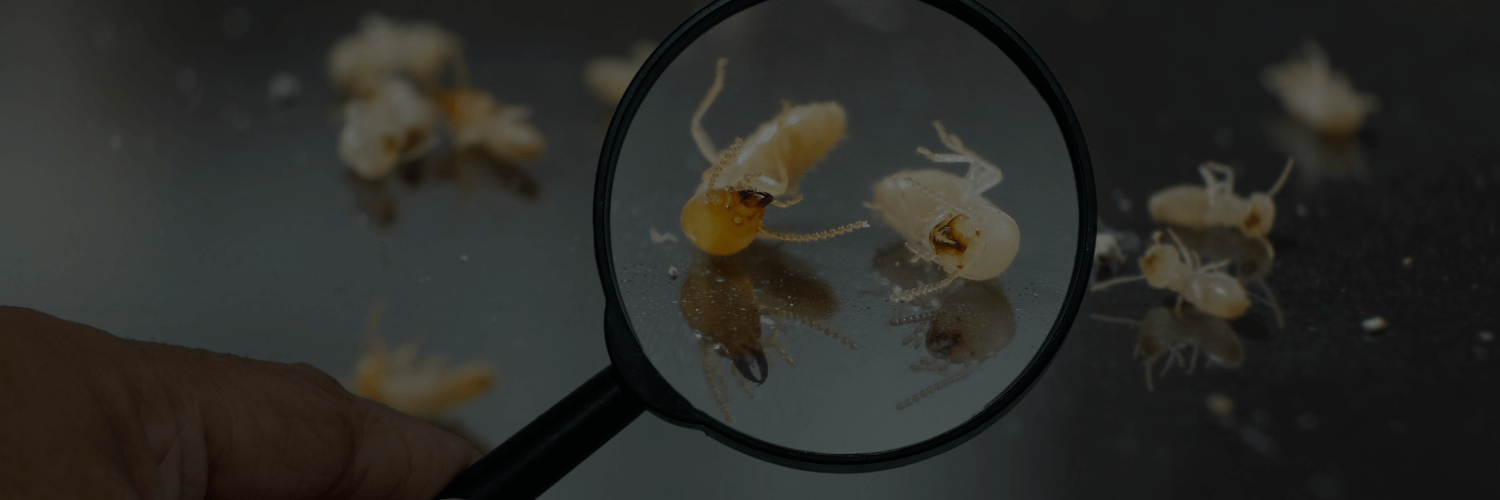
Say goodbye to termite infestation with the Best Termite Treatment from ORIGIN Exterminators
Termite Treatment for Termite Infestation in Singapore
Introduction to termites
Termites are insects that forage for cellulose, typically found in everyday items like wood, paper, and cardboard. They live in colonies and cause damage to wooden structures like door frames, beams and flooring. Termites pose a significant threat to both residential homes and commercial establishments alike.
Why do I have termite infestation?
Termites thrive on wood and moisture, so if there is any damaged wood or cardboard boxes lying around this is a good food source. Termites easily gain access to your property through cracks in the building. With these ideal conditions mentioned, you can have yourself an extensive termite infestation! ORIGIN's Termite Treatment professionals offer several treatment and control methods to detect and eradicate termites.
Why choose ORIGIN ?
ORIGIN Exterminators has been in the pest control industry for more than three decades, and we have become one of the most well-known companies delivering professional termite treatment methods in Singapore. Termites are strong in numbers, with colonies consisting of up to 2 million members, thriving in the soil deep underground. This makes them a particularly challenging pest to control. ORIGIN's termite elimination team offers several termite treatment and control methods to detect, locate, and eradicate termites.
Signs of Termite Infestation
- Discarded wings or alates: Alates are winged termite swarmers will mate and become the king and queen, finding a suitable nesting site to build a new colony. They are the first outwardly visible sign of a possible termite infestation.
- Wood damage: Termites feed on the cellulose within the wood, leaving behind a thin layer of wood on the surface, causing the wood to become hollow and brittle.
- Mud trails: Subterranean termites build mud tubes to retain moisture when they are in transit between their food source and colony. Mud tubes are commonly found near the property's foundation, entering through cracks in the foundation.
- Frass: Unlike Subterranean termites, Drywood termites infest and tunnel inside dry wood and produce wood-coloured droppings. If homeowners observe a small pile of pellets inside or around the house, it is an indication of drywood termite infestation.
- Peeling or bubbling paint: Uneven or bubbling paint occurs due to moisture build-up. Both water damage and termites can be the cause.
Prevention Tips
- Remove moisture sources: Areas around pipes usually have high humidity levels, which termites thrive in. If you have leaks, this is a hotspots for termite infestations and these needs to be fixed.
- De-clutter your house: Old magazines, cardboard, and newspapers provide a conducive environment for termites to thrive. Remove all cellulose-based materials like paper and cardboard.
- Never break open or disturb a mud trail: If you do find a mud tube, the worst thing you can do is disturb them. It is important that you don’t spray the mud tube with any DIY or store-bought products. Unfortunately, once termites have been disturbed they will completely abandon that area, which means they could come up somewhere new.
- Keep you garden and external areas clean and tidy: Remove old, rotten wood, and trim overgrown plants, that might give termites access to the building. In addition, try to ensure all garden mulch is keep at a good distance away from the concrete building to keep it safe from termite.
Termite Detection using Thermal Imaging
When you have a termite problem or want to protect your property from these silent invaders, ORIGIN applies a science-based approach to identify the root of your problem and implement a solution.
Our Termite Specialist will carry out a Termite Inspection using a Thermal Imaging Camera. He will inspect wooden skirtings, door-frames, false ceilings etc. and look out for any water leakage areas.
A Thermal Imaging Inspection will detect variations of temperature with a sensitivity of 0.1 degree Celsius. He will then provide you with a report to highlight the surfaces that show thermal abnormality which is susceptible to termite infestation.
Do also request for a free quote for termite treatment services.
ORIGIN's Solutions for Complete Termite Eradication and Protection
Termite baiting is the most preferred method of termite treatment. It helps in dealing with the underground subterranean termite colony. Termite bait stations, placed either in-ground or above-ground, are equipped with wood or cellulose materials that attract termites. These bait stations contain a slow-acting insect growth regulator (IGR), which disrupts the termite's molting process. Foraging termites consume the bait and carry it back to the colony, where it is spread through grooming and feeding activities. This gradual process ensures that, over a period of 3 to 6 months, the entire termite colony is effectively eliminated.
ABOVE GROUND STATIONS
Our technicians begin by installing Above Ground Stations along active mud trails, which termites use as pathways between their colony and food sources. These stations attract termites to feed on specialised termite bait.
This bait is less toxic than table salt, making it safe for children, pets, and non-target animals, and it doesn't harm beneficial insects like earthworms or caterpillars. The bait is slow-acting to ensure it circulates throughout the termite colony, achieving 100% elimination. Over a few weeks, we replenish the bait as needed, allowing termite workers to distribute it throughout the colony for complete eradication. As the bait takes effect, termite activity diminishes, and the stations will eventually removed.
IN-GROUND STATIONS
To prevent re-infestation by other termite colonies and provide additional peace of mind, ORIGIN can install In-Ground Stations around your property as a preventative measure. There are two main types of stations: Soil In-Ground Stations used in landscaped areas, with covers that are flush with the ground and lockable to prevent unauthorised access. Concrete In-Ground Stations are suitable for driveways, tiled areas, and concrete surfaces. These stations have durable covers that are also flush with the ground and lockable, designed to withstand high vehicle traffic.
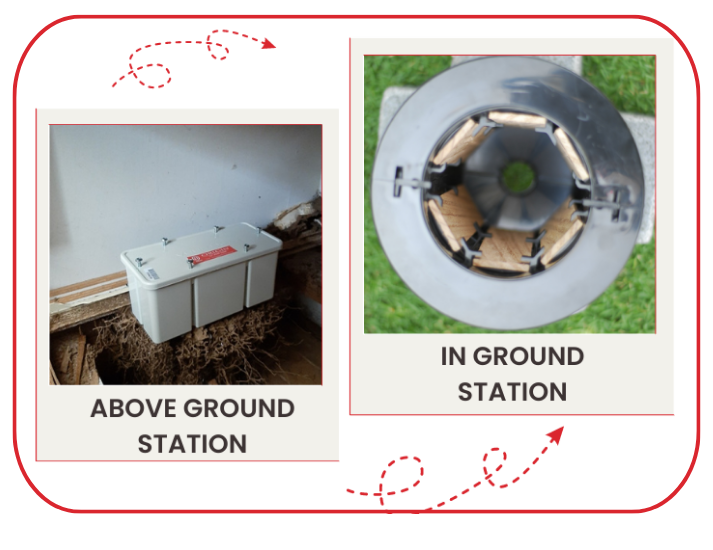

Termite Treatment Methods
Effective termite treatment in Singapore involves curative and preventive methods to address infestations comprehensively. Professional termite exterminators offer both long-term solutions and quick fixes.
Soil Drenching
Subterranean termites live in soil beneath trees. Soil Drenching is spot treatment for garden species, which helps trees from termite damage. This is the process of digging a trench in the soil surrounding the perimeter of the tree to deliver the termiticide treatment, allowing the termiticide to flow down into the soil.
Drywood Termite Treatement
For drywood termite infestations, spot treatments are crucial. Method includes Foam Insecticide treatment. A specially formulated termiticide foam is injected into small holes in the wood or areas where termites are active. As it expands, the foam penetrates deep into voids, cracks, and crevices within the wood, effectively killing the termites. This process ensures that the foam reaches even the most difficult areas, leaving a residue that continues to eliminate termites upon contact.
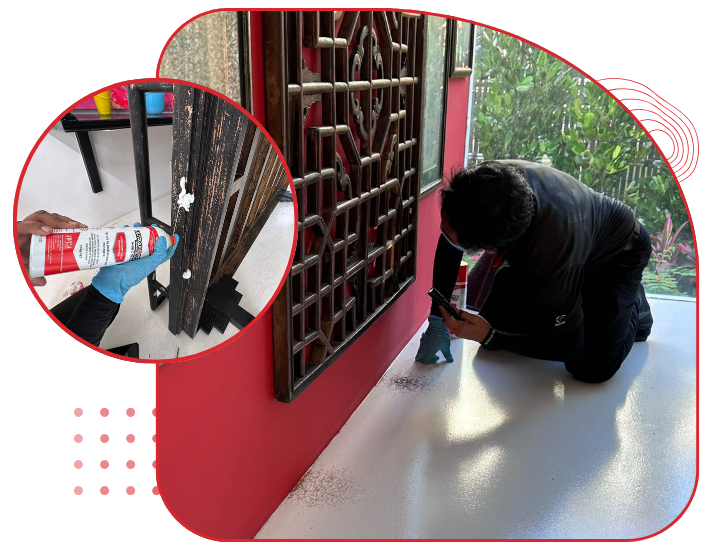

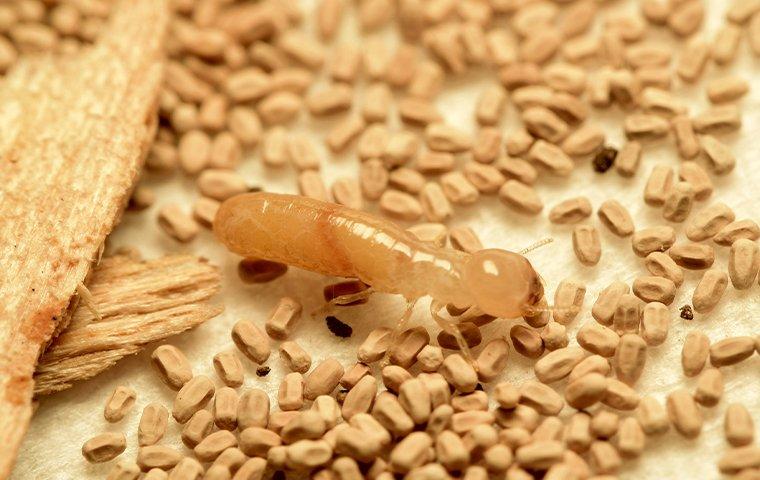
BIOLOGY
light to medium brown in colour
9mm to 13mm in length
BIOLOGY
Eggs: small and white
Nymph: immature termites with softer bodies.
Adult: upon reaching adulthood, termites are capable of reproducing and continue to feed on the wood they are infesting.
BEHAVIOUR
Unlike Subterranean Termites that need a constant source of moisture to survive, Drywood termites are able to extract moisture from the wood they are consuming.
BREEDING
When a suitable location has been found for the colony, the female begins to lay eggs and grow the colony.
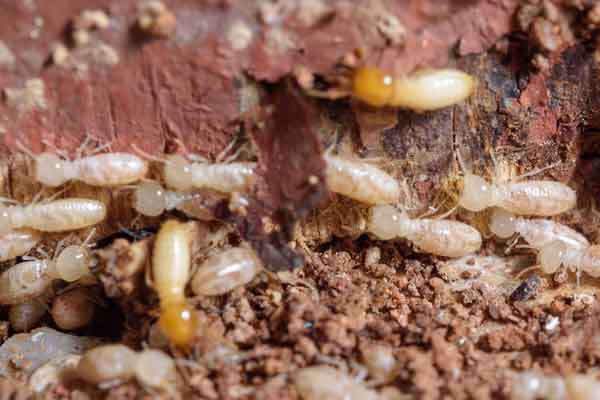
FEEDING
Drywood termites feed on dry, untreated wood and can infest a wide range of wooden structure and objects like furniture, flooring, walls and beams.
HOMES
They established their colonies in dry, sound wood that is not contact with soil, because they do not need a moist environment or access to soil to survive.
IDENTIFY
Drywood termites are hard to detect because they eat and live in the wood. But they leave behind small piles of faecal pellets that resemble sawdust.
APPEARANCE
Wings are longer than their body length, and have a series of veins that run through them.
-2.png)
INSPECTION
Our professionals are trained to meticulously seek out Drywood Termites. They also take into consideration structural issues, housekeeping practices as well as surrounding environments.
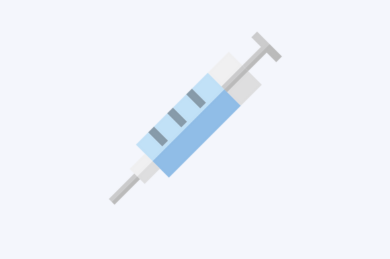
FOAM TREATMENT
A specially formulated foam is injected into the termite galleries within the wood. As it expands, the foam penetrates deep into the voids, providing effective termite treatment by suffocating the termites and destroying the eggs.

PROFESSIONAL ADVICE
Based on our inspection of your premises and the contributing factors that may be involved, our technician will offer advice on how to prevent a future Drywood termite infestation.

SERVICE REPORT
After the service is done, a digital report will be emailed to you. This report contains photos of the problematic spots and the treatment done, along with suggestions specific to your site.
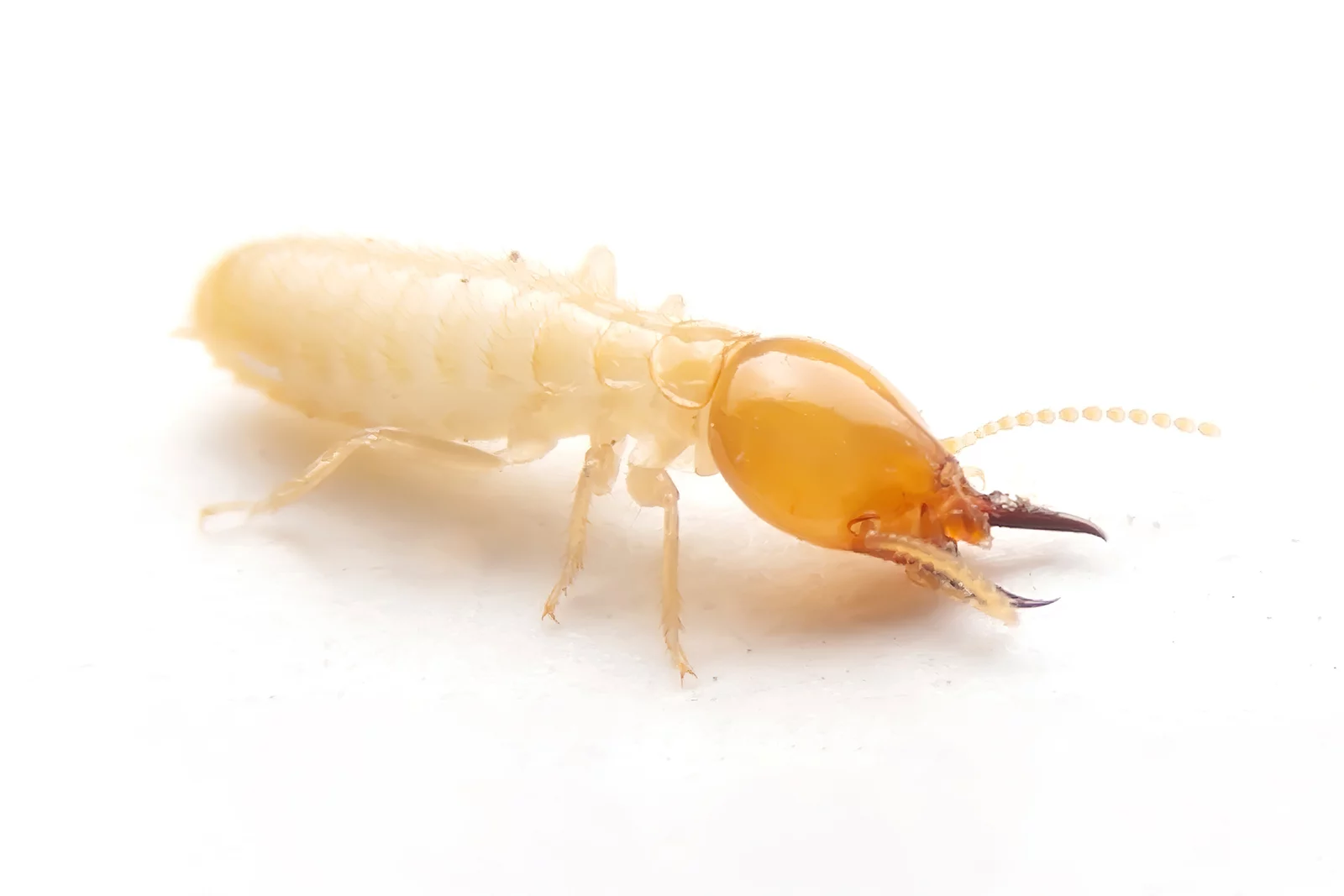
BIOLOGY
light to medium brown in colour
9mm to 13mm in length
BIOLOGY
Eggs: white or translucent
Nymph: immature termites with softer bodies.
Woker: forage, build and maintain the nest, care for the young.
Soldier: defend colony
Reproductive stage: when the colony has matured and environmental conditions are suitable, some nymphs moult into reproductive winged termites (alates or swarmers) to mate and start new colonies.
BEHAVIOUR
Subterranean Termites have a specialised grooming behaviour called allogrooming, where they groom each other using their mandibles and specialised grooming organs on their bodies. They remove debris, fungus and parasites from each other’s bodies to reduce risk of disease transmission.
BREEDING
Every colony has a queen which is responsible for maintaining the population - she lays hundreds to thousands of eggs a day.
BREEDING
Subterranean Termites build their nests in soil, wood or other materials that are in contact with the soil.
FEEDING
They feed on wood, paper, and other cellulose materials.
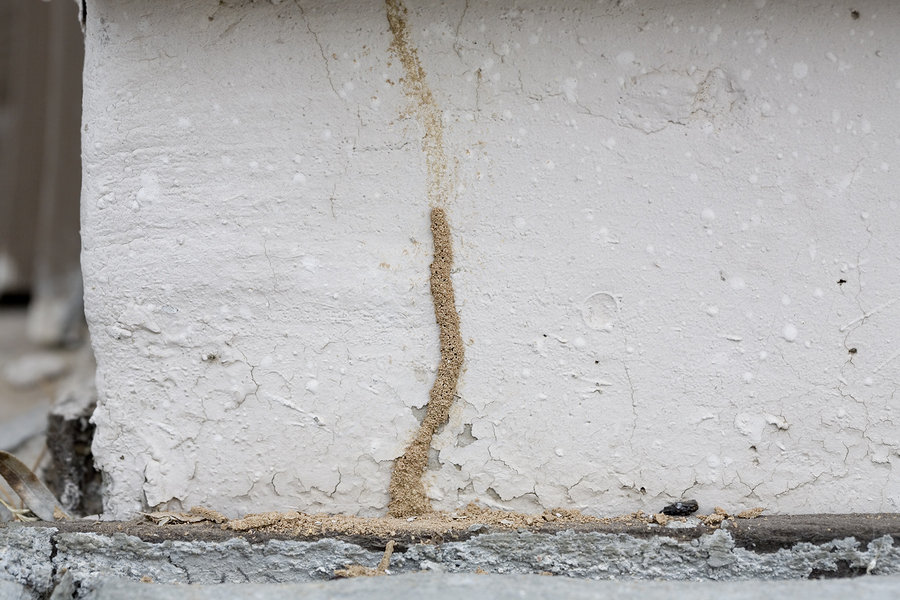
IDENTIFY
Subterranean Termites need moisture to survive - they build mud tubes to provide a protected pathway for them to forage for food or reach new areas.
COMMUNICATE
Their queen produces pheromones that help regular the behaviour and social structure of the colony. She can also suppress the development of other reproductive termites to ensure she’s the only fertile female in the colony.
COMMUNICATE
Grooming also helps to spread chemical signals throughout the colony for the termites to communicate and coordinate behaviour. They also use these signals to identify nestmates, locate food sources and coordinate the construction and maintenance of their nest.
-2.png)
INSPECTION
Our Technicians are trained to meticulously seek out subterranean termites. They also assess structural issues, housekeeping practices, and the surrounding environment.
.png)
IN-GROUND BAITS
These are installed in the ground. These stations have baits containing a slow-acting substance that the worker termites can bring back to the colony to spread to their nestmates, leading the eventual wipeout. This is a very effective form of termite treatment.
.png)
ABOVE-GROUND BAITS
Placed in areas where termites are known to be active, these bait stations are filled with a substance that has delayed effects, allowing time for the termites to consume it and take it back to their colony, thereby further enhancing the termite treatment provided by the in-ground stations.

PROFESSIONAL ADVICE
The stations not only helps to control the current termite infestation problem. You can protect your property through this proactive termite management system that can prevents future ones.

SERVICE REPORT
After the service is done, a digital report will be emailed to you. This report contains photos of the problematic spots and the treatment done, along with suggestions specific to your site.
Frequently Asked Questions
Yes. Due to our humid and tropical climate, termites in Singapore are a year-round concern—especially for homes with wooden structures or older buildings. Regular checks and preventive termite treatment are essential to protect your property.
The most common types of termites in Singapore include:
- Subterranean termites (build mud tubes and cause structural damage)
- Drywood termites (live directly inside wood)
Each species requires a different termite treatment approach, which our experts at ORIGIN can identify and customize.
Our comprehensive termite treatment includes:
- Thorough on-site inspection
- Use of baiting systems, liquid barriers or foam treatments
- Safe, targeted application based on the infestation level
- Ongoing monitoring and follow-up where necessary
We focus on both immediate elimination and long-term prevention.
The duration depends on the severity of the termite infestation and the treatment method used. Some treatments are completed in a few hours, while baiting systems require monitoring over several weeks. Our team will explain the timeline after the initial inspection.
Cost varies based on property size, infestation severity and the type of termite treatment needed. At ORIGIN, we offer transparent pricing with no hidden fees; along with tailored recommendations that deliver long-term protection.
After your termite treatment, we recommend:
- Regular inspections (especially for landed properties)
- Fixing water leaks and improving ventilation
- Avoiding wood-to-ground contact
- Removing unused timber or cardboard storage containers
ORIGIN also provides preventive maintenance plans for long-term peace of mind.
ORIGIN Exterminators has over 35 years of experience treating termites in Singapore. Our science-based, environmentally responsible methods are trusted by thousands of homeowners. We do not just treat the problem—we protect your property for the future.
Unfortunately, DIY treatments only address surface-level symptoms. Termites often live deep inside walls, foundations or flooring. Only professional termite treatment can fully eliminate the colony and prevent them from returning.
GET IN TOUCH
General enquiries and contract-related matters
SALES@ORIGIN.COM.SG
Questions about your pest management program
QA@ORIGIN.COM.SG
Concerns with service standards and appointments
OPERATIONS@ORIGIN.COM.SG
Blog
ORIGIN Pest Control Blog: Expert Insights & Tips.
Discover expert insights and helpful tips on pest control from ORIGIN's trusted professionals.
How To Deal with Termite Infestation in Singapore?
How do you know if you have termite infestation? Common telltale signs fare mud tubes, wooden frass/pellets, tiny holes in wooden surfaces, and...
What To Do When You Find Termite infestation
What happens if you find termites in your house? Termites are probably the most damaging pests of all. Termites alone are responsible for over $10...
Easy-To-Spot Signs Your Home Might Have Termite Infestation
Termites are probably the biggest problem you can have while maintaining your home. Commonly referred to as ‘White Ants’, termites are far from the...
What Should You Do if You Suspect a Termite Infestation?
A termite infestation can be frustrating and challenging for any homeowner. They silently chomp into the structure of the inner walls, eating away...
How to Identify & Eliminate Termite Infestation in Singapore
Termites (commonly known as White Ants in Singapore) are the most feared pests to property owners because of the costly damage that their infestation...
Survey Results: Secure Your Home Against Termite Infestation
Termite infestation are one of the common infestations across the globe. These tiny pests are smaller in size but have the capability to badly damage...
Learn All about Termite Infestation, Damage and Control
Termites, popularly known as ‘white ants,’ have nothing to do with ants. They are a separate species of insects, dating back to the time when...
Eliminate Termite Infestation Before They Take Over
Are you a property owner, a business owner, or in charge of building management and services? If so you wouldn’t be surprised to hear of termite...
A Guide to Handling Termite infestation in the Garden
Have you recently spotted tiny, white insects in a cluster creeping around a tree in your garden? Be very careful as you may be dealing with...
WHAT CAN WE DO FOR YOU?
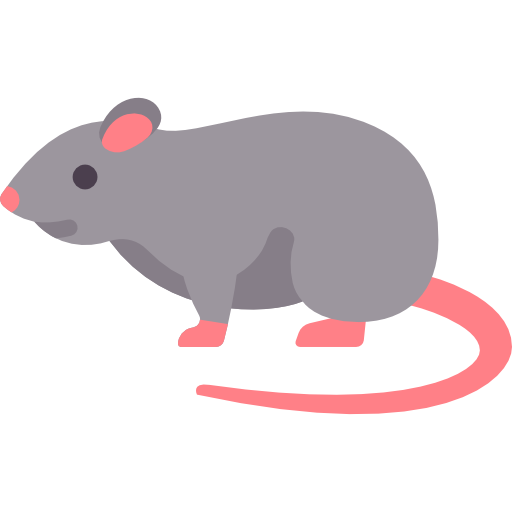
Effective solutions to eradicate disease-carrying rodents and prevent reinfestation.
.png?width=512&height=512&name=pasted%20image%200%20(13).png)
Advanced mosquito control services like 3+1 and others targeting dengue vectors and breeding sites
.png?width=512&height=512&name=Untitled%20(3).png)

.png?width=512&height=512&name=pasted%20image%200%20(11).png)
.png?width=512&height=512&name=Untitled%20(4).png)
.png?width=512&height=512&name=Untitled%20(5).png)

.png?width=512&height=512&name=pasted%20image%200%20(12).png)
